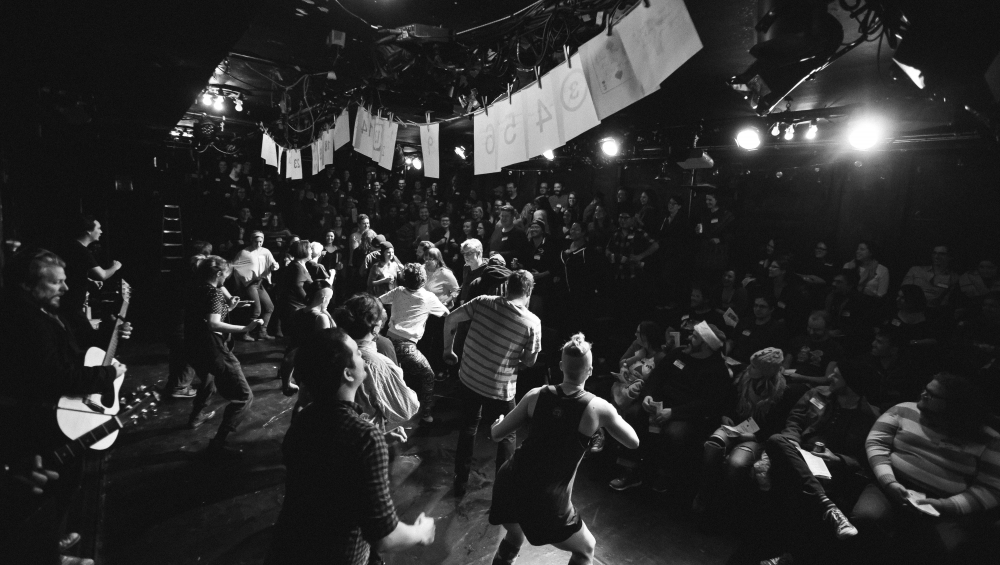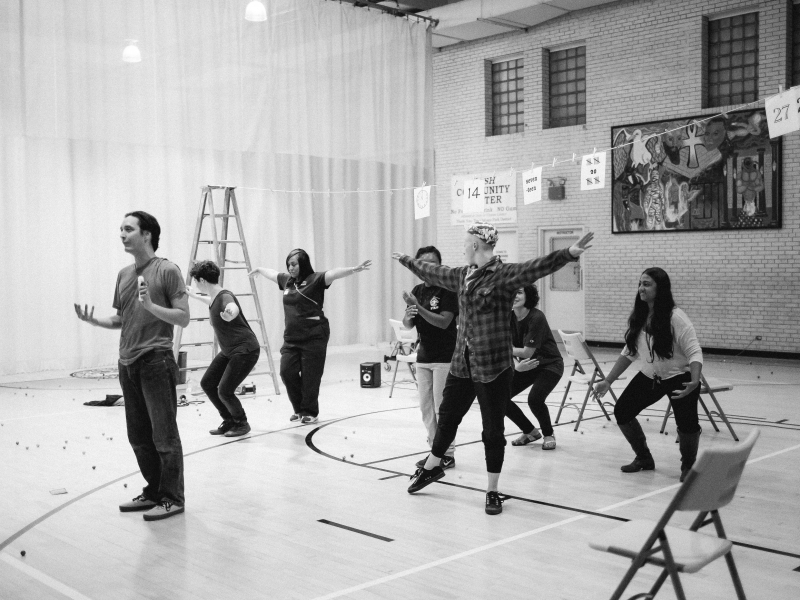That title is the Onion article headline I imagine would come out if the show Too Much Light Makes the Baby Go Blind was as nationally recognized as, oh I don’t know, President Obama.
Don’t worry, you’re not about to read my take on an Onion article. Those people are way funnier than me. I’m not going to do that and I can’t write for them because I’m about to do something so Neo-Futurist by explicating the humor and intention behind my own faux-headline above. Sincere apologies to those that clicked into this post thinking they were getting into a clever piece of satire and not a pedantic argument. After all, I am who I am (Neo-Futurist!).
My intention in that headline is to draw an important distinction in the sand between “Too Much Light Makes the Baby Go Blind” vs. “The Neo-Futurists,” between “30 Plays In 60 Minutes” vs. “Neo-Futurism / non-representational theater.” And hopefully that intention is achieved in that title by pointing out the ridiculous idea that improvisation could A) “close its doors,” B) lay claim as the longest-running art form in one city, and C) be perceived as having only existed for merely decades.
I want to walk you through my personal journey of becoming a fan of Too Much Light, a champion of theater that experiments, a proponent of injecting actuality into those experiments, and a leader of ensemble-driven Neo-Futurist work. This is incomplete, and in no particular order (Neo-Futurist!):
- As a very young person, I got into the theater arts not by being in the audience of my first Broadway musical, but rather when I was backstage at the ballets my mom used to costume design. I liked watching the dancers’ attitudes and bodies change between the moment they were visible to an audience (postured, poised, bright), and when they were out-of-sight (severe, determined, concentrated).
- When I was introduced to the idea of realism, I liked watching the balancing act between performers/actors in a Chekhov play, alternatively failing and succeeding at their task of both being in character and telling the story. It was hard to quantify when it worked and when it didn’t, but when it did, there was always a leaning towards (no: charging[!] towards) something that was honest.
- I saw Spalding Grey sit at a desk and read/tell his writing to a crowd of people invested in his lived experience. He stood up only once, and danced to music coming from a portable cassette tape player.
- My freshman year in college, a group in my Theater 101 class presented some plays from one of the Too Much Light books. I was intrigued, and promptly forgot about it.
- When I first moved to Chicago, I was cast as a Sugar Plum Fairy in a rock-and-roll children’s theater adaptation of The Nutcracker. The audience reacted most positively when I made no attempt at being in character at all, and was just myself running around the stage dressed as flamboyantly as you can imagine.
- I took a class at The Neo-Futurists taught by John Pierson and Dean Evans. I learned a lot about Neo-Futurism, but more importantly/specifically I learned that I could make my own plays, that I could not only [try to] be myself onstage but also use my body/presence to convey an infinite amount of stories in the room without Wayne’s-World-transporting the audience to a fictional realm.
- I’ve witnessed Back Room Shakespeare gloriously throw the idea out the window that truth and honesty onstage (and with an audience) was inherently tied up in personal narrative, or even in what my own theater company has often called “new” (i.e. Shakespeare wrote his plays a really long time ago). I’ve witnessed Salonathon gloriously construct and then launch every type of identifying person off trampolines of artist empowerment. And I’ve welcome the influence of that work — as well as countless other Chicago performance-makers — shape and change The Neo-Futurists, in an attempt to avoid stagnation.
- This morning I listened to veteran Neo-Futurists Dave Awl, Rachel Claff, and Phil Ridarelli excitedly and eloquently cheer on the future of The Neo-Futurists, Neo-Futurism, and the experimental artmaking factory that is Chicago, despite the fact that our own personal label maker refuses to print.
All that’s to say: the company and the artmaking goes way beyond TML, beyond any individual.
Like I said, those bullets make up an incomplete timeline, in capturing both my personal experience and the broader reach of what defines this company and its work. But I trust that many of you, who are fans of and advocates for the same work that I list above, have similar journeys in the world of performance and theater. And I trust that when we talk about continuing on, past the point at which Too Much Light Makes the Baby Go Blind ends, you understand that it’s only another step in the long history of a movement, in which you, me, and The Neo-Futurists will continue to be a part of.
Hope to see you out there braving the cold tonight and through the weekend, trying to pick up those last remaining walk-up tickets. And if you can’t make it just wait for the summer. It always comes back.
Too Much Light Makes the Baby Go Blind celebrates with its last three anniversary “Best Of” shows this weekend to include not only the best/favorite plays of 2016, but also personal favorites of all time. The very last performance of Too Much Light will be December 31st, after which The Neo-Futurists will continue to add its roster of 9,775 short plays (and 50+ longish ones) since 1988. Go to neofuturists.org for consistent updates.

